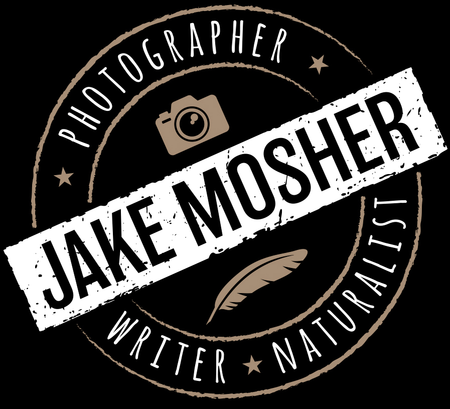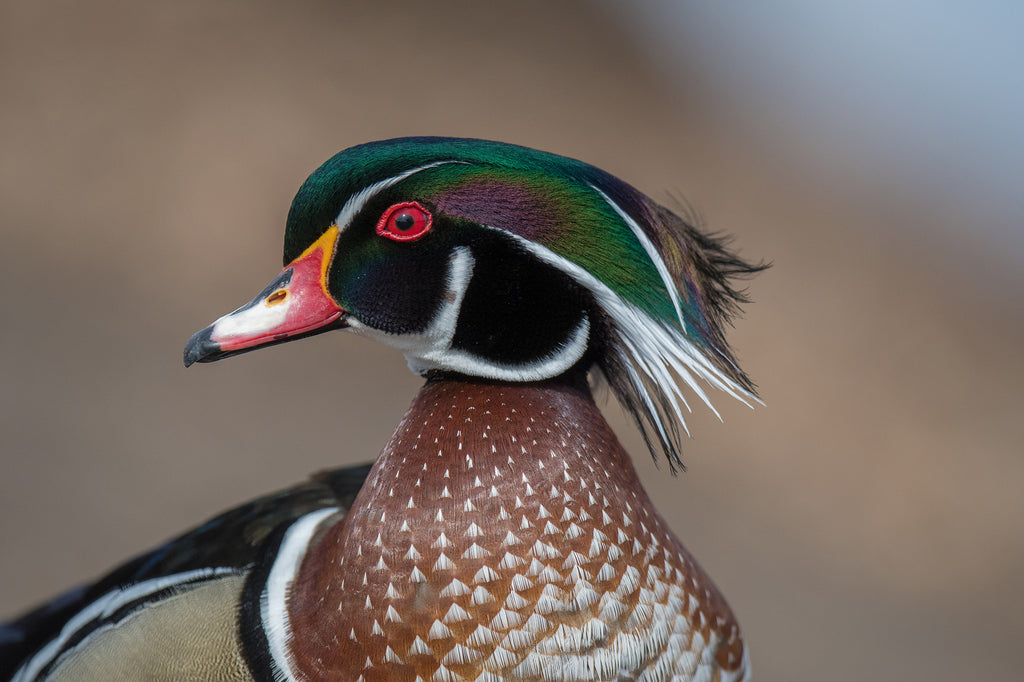It’s no wonder I like color. Growing up in the North Country, where muted shades of grey and white define the landscape for more than half the year, I’ve always been drawn to anything vibrant. From the time I was two years old and found the blue neck of a Phillips Milk of Magnesia bottle leaking from the bank of a stream my father and I fished, anything brightly colored in the wild, particularly birds, has caught my eye. The red comb on a pileated woodpecker’s head. The iridescent blue on a hen mallard’s wing. The emerald flash of a ruby-throated hummingbird in the sun. The Chinese golden pheasants on display at the county fair, and, more than any of them, the spectrum shades of brilliant feathers on a drake wood duck.
Like color, I’ve also been drawn to a quest. Seeking is in my blood as surely as granite lies under the shallow, Vermont soil where I spent my boyhood digging for old bottles in farm dumps, collecting rocks and minerals – sometimes chiseling them out of the frozen ground under our front porch when winter curtailed my searching elsewhere – catching and framing butterflies, and yes, even roaming the hardwood ridges near my home looking for shed feathers from the birds I loved seeing.
In keeping with my innate urge to discover, my favorite stories growing up were myths, and my favorites of those involved the arduous journeys of Odysseus and Jason of the Argonauts. My golden fleece, in a world so sadly devoid of Scylla and Charybdis, was a male wood duck, and I wanted one more than anything else on Earth.
I remember sitting in Frank’s Steakhouse in Newport, Vermont, mesmerized by the array of big-game animal mounts the owner had collected from all over the world. The arrangement, which included a life-size polar bear and Alaskan brown bear gripping a crimson, sockeye salmon in its mouth, was not complete in my young eye because it was missing a wood duck. The giant caribou, the crossed swords, and the elliptical buffalo hide shield from Africa were all interesting, but without that particular bird the display fell short of the one I dreamed about.
Dreaming was all I could do until I turned 12 and completed hunter’s safety – a rite of passage for all boys of my generation in Vermont – but once armed with that sacred certificate (and a light-weight 16 gauge shotgun), I began a quest for a wood duck. It’s a search which has spanned three decades and more than 2000 miles, from the backwaters of north-flowing Vermont rivers to the great Yellowstone in Montana. That’s where I was early this spring, packing a Nikon camera instead of the single-shot H&R I patrolled Northern Vermont with, lying on bankside ice and fallen leaves, my body willed to complete stillness, eyes focused on the wake from a pair of ducks about to pass directly in front of me. Thirty-two years of seeking was coming to an end, and with my face pressed close to my viewfinder, finger on the shutter release, I saw in vivid detail many of the places I’d looked.
There was Lord’s Creek in Irasburg, Vermont, a much calmer stream during the October duck season than during the May rainbow trout run. I saw the pool on the bend just downstream from a wooden tractor bridge where a large male rainbow spooled all the line off my reel and hung tired on the surface forty yards from me. My father went into the water that day like an otter, and somehow he came out with my fish wrapped in his arms. I saw the creek’s oxbows half a mile upstream from there on a sleety morning when my right thumb was too numb to cock my shotgun as a pair of drake wood ducks flew straight into the sky, rising like the Phoenix, colors disappearing in ice fog, shrill cries fading from earshot, vanishing like the hope I’d felt earlier that morning dressing in camo before our wood stove.
I saw a slough off the Black River, thick with fallen, rusty-yellow ash leaves, and remembered pushing myself up from my belly, coat and pants caked with mud, flushing a lone wood duck drake I hadn’t noticed, watching helplessly as it flew safely out of range.
Other birds leapt from cattails along the shore of a huge swamp behind Round Hill, veering crazily in the sky while I stared from two hundred yards away, streaking south along the base of Irasburg Mountain, dots eventually lost against a horizon of naked trees.
Just before the pair of birds before me on the Yellowstone swam into my viewfinder, I saw myself slowly raise my shotgun on a day of unsettled weather and fast-moving, late-fall clouds thirty years earlier. I saw the drake turn unaware on the surface, its red eye passing out of sight, a ray of sun lighting the purple feathers on his back. Then the water exploded all around him as lead BBs smashed down, miniature geysers forced up in every direction, the smell of burnt gunpowder heavy and acrid. I stood dumbfounded as the surface settled, staring at a patch of water which moments before had held the object of my obsession and now held only the reflection of alders. Where had the drake gone? It was a question I’d tried to answer by stripping to my underwear and wading through every inch of the spring hole he’d been in. For an hour, while seasons battled overhead, I waded back and forth until my legs no longer moved of their own accord and I could not stop shivering. The bird had simply vanished, either entirely a figment of my imagination or, as I like to think now, pulled suddenly into some other dimension to extend my quest.
It’s the seeking I love most, I thought, as I gently pressed to release my camera’s shutter, swiveling slowly to follow the swimming pair. The hen heard the click, her eye fixing the location, her feet pushing her faster, out ahead of her mate.

“That works,” I whispered to myself as I reviewed the picture, half wondering if it would vanish from my screen. It didn’t, and like adrenalin at the end of one of my former boxing matches, draining so fast I sometimes felt nauseous, I realized my journey for a wood duck had come to an end. Again memories from long ago flooded in, this time in snap-shots of a broken zipper on the hood of my first Goretex jacket, a skim of ice glowing in the last light on the last day of a very distant duck season, and of a full moon near Halloween bisected by a V of flying geese. I lingered on the image from that night long enough so that when I blinked and found bright, afternoon sun shining on the Yellowstone I was disoriented. With a cry from the drake, the wood ducks turned and swam past me again, and on a stage of sunlit water, he posed, clapped his wings, and dove headlong beneath the surface.



Seemingly unafraid, the pair swam to shore and crawled up onto the bank twenty feet from where I sat, my shutter whirring. And then, on the edge of spring, on the edge of the Yellowstone, on the edge of needing to find a new quest, I witnessed a little bit of magic. A full two months earlier than I’ve ever seen a single wood duck arrive in Montana, they began touching down all around me, more than two dozen of them, landing on shore, in the water, and in the cottonwoods overhead, some so close my lens wouldn’t focus on them. As inexplicably as one had vanished so many years earlier in Vermont, they appeared that afternoon in Montana, their plumage glowing in sinking sunlight. They looked curiously at me, no doubt wondering what type of cyclops stared at them, the large front element of my 500mm telephoto reflecting in some of their eyes. One admired his reflection in a puddle of freshly-melted snow while another swam in front of a mallard drake, ruffling his feathers in s show of splendor.




On shelf ice, a pair nestled close together, the drake sneaking a peck on the check before both closed their eyes.

I took 800 pictures before the sun fell behind the height of land which separates the Yellowstone drainage from the Missouri. In the waning light, one drake hopped onto a bench along a walking trail by the river. He shook his entire body then jumped onto the back of the bench, puffed himself up the way I’ve seen birds do on cold mornings, and called for a long time. Whether he sang to an unseen mate, was saying good bye to the day, or heralding night, I don’t know. His red eye met mine as he continued calling. “Find another dream,” he seemed to say.


I sat until dark. Until I could no longer see any ducks and my hands told me that despite the approach of the equinox Montana still rested very much in winter. I wondered what will come next for me. There will be something, I’m sure. After all, I’m a seeker. Another bend. Another mountain. Another day.
“There’ll be something,” I said quietly. On the edge of earshot, nearly lost in the traffic on I-90, a great horned owl affirmed it.
*Many of these photos are now for sale. You can find them under the North Country Birds tab, or search by title: Bed Head, Ruffled, Spring Friends, Peck on the Cheek, Hear ye, Hear ye, Mirror Mirror, Diver Down, and Two of a Kind




Annie
Beautiful.
Tanya Sousa
When you reach your goal, you certainly do it with the same vibrancy of those colors you’ve always loved. Looking forward to seeing and reading about your next quest. :-)